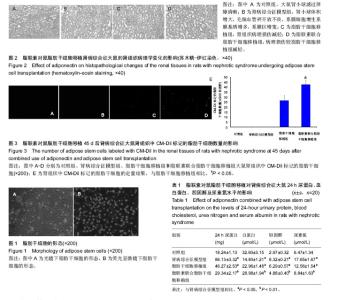| [1] Gibson KL, Glenn D, Ferris ME. Back to the future: therapies for idiopathic nephrotic syndrome. Blood Purif. 2015;39(1-3): 105-109. [2] Bierzynska A, Saleem M. Recent advances in understanding and treating nephrotic syndrome. F1000Res. 2017;6:121. [3] Colucci M, Corpetti G, Emma F, et al. Immunology of idiopathic nephrotic syndrome. Pediatr Nephrol. 2018;33(4):573-584. [4] Zuk PA, Zhu M, Mizuno H, et al. Multilineage cells from human adipose tissue: implications for cell-based therapies. Tissue Eng. 2001;7(2):211-228.[5] 陈红梅,沈英杰,房艳.ADSCs对糖尿病肾病大鼠肾纤维化的抑制作用[J].解剖科学进展,2015,21(3):236-240.[6] Sheashaa H, Lotfy A, Elhusseini F, et al. Protective effect of adipose-derived mesenchymal stem cells against acute kidney injury induced by ischemia-reperfusion in Sprague-Dawley rats. Exp Ther Med. 2016;11(5):1573-1580.[7] 郭志伯,张晨洁,马李娜,等.脂肪间充质干细胞移植联合人工虫草多糖改善肾病综合征的高凝血状态及肾功能[J].中国组织工程研究, 2016,20(50):7549-7556.[8] 郭佳,肖传实,白瑞,等.脂联素对大鼠缺血/再灌注心肌细胞凋亡及相关蛋白表达的影响[J].中国药理学通报,2012,28(7):930-933.[9] Opatrilova R, Caprnda M2, Kubatka P3, et al. Adipokines in neurovascular diseases. Biomed Pharmacother. 2018;98: 424-432. [10] Schmued LC, Stowers CC, Scallet AC, et al. Fluoro-Jade C results in ultra high resolution and contrast labeling of degenerating neurons. Brain Res. 2005;1035(1):24-31.[11] Kuroda K, Kabata T, Hayashi K, et al. The paracrine effect of adipose-derived stem cells inhibits osteoarthritis progression. BMC Musculoskelet Disord. 2015;16:236. [12] Letra L, Rodrigues T, Matafome P, et al. Adiponectin and sporadic Alzheimer's disease: Clinical and molecular links. Front Neuroendocrinol. 2017. doi: 10.1016/j.yfrne.2017.10.002. [13] Adolph TE, Grander C, Grabherr F, et al. Adipokines and Non-Alcoholic Fatty Liver Disease: Multiple Interactions. Int J Mol Sci. 2017;18(8): E1649. [14] 朱慧娟,任嘉庆,于双玉.肥胖儿童血浆脂联素水平及对肾损伤作用[J].中国公共卫生,2010,26(1):25-26.[15] 桂定坤.黄芪水提物促肾脏水钠排泄及肾脏保护作用的细胞分子机制研究[D].上海:复旦大学,2007.[16] 许文芳,柳红梅.应用磺基水杨酸-硫酸钠比浊法在自动化分析仪上测定尿蛋白[J].检验医学,2007,22(1):23-24.[17] 张茵,银永革.肾病综合征的治疗进展[J].医学综述,2014,20(2): 260-262.[18] 樊威伟.肾病综合征与相关细胞因子的研究及治疗进展[J].湖南中医杂志,2014,30(2):150-152. [19] 何开英.肾病综合征中医治疗研究进展[J].亚太传统医药,2016, 12(1):44-45.[20] 李可.脂肪组织对其他组织器官的调控作用[J].中国高新技术企业, 2017(8):88-89.[21] Sweiss N, Sharma K. Adiponectin effects on the kidney. Best Pract Res Clin Endocrinol Metab. 2014;28(1):71-79. [22] 张同梅.脂联素与多种疾病关系的研究进展[J].实用心脑肺血管病杂志,2015,23(2):4-7.[23] Yano Y, Hoshide S, Ishikawa J, et al. Differential impacts of adiponectin on low-grade albuminuria between obese and nonobese persons without diabetes. J Clin Hypertens (Greenwich). 2007;9(10):775-782.[24] Nolan E, O'Meara YM, Godson C. Lipid mediators of inflammation in obesity-related glomerulopathy. Nephrol Dial Transplant. 2013;28 Suppl 4:iv22-29. [25] 侯洁,许芳,许颖.脂联素与慢性肾脏病的研究进展[J].中华临床医师杂志(电子版),2016,10(11):1595-1600.[26] Perri A, Vizza D, Lupinacci S, et al. Adiponectin secreted by tubular renal cells during LPS exposure worsens the cellular inflammatory damage. J Nephrol. 2016;29(2):185-194.[27] O'Halloran N, Courtney D, Kerin MJ, et al. Adipose-Derived Stem Cells in Novel Approaches to Breast Reconstruction: Their Suitability for Tissue Engineering and Oncological Safety. Breast Cancer (Auckl). 2017;11:1178223417726777. [28] Tabatabaei Qomi R, Sheykhhasan M. Adipose-derived stromal cell in regenerative medicine: A review. World J Stem Cells. 2017;9(8):107-117. [29] Bora P, Majumdar AS. Adipose tissue-derived stromal vascular fraction in regenerative medicine: a brief review on biology and translation. Stem Cell Res Ther. 2017;8(1):145. [30] 祁美武,周晓.脂肪干细胞的研究进展[J].中南医学科学杂志,2015, 43(3):342-345.[31] 孙惠君,李博,陈书强,等.脂肪干细胞的研究进展[J].现代生物医学进展,2016,16(12):2380-2383.[32] Lim S, Cho H, Lee E, et al. Osteogenic stimulation of human adipose-derived stem cells by pre-treatment with fibroblast growth factor 2. Cell Tissue Res. 2016;364(1):137-147. [33] Brown CF, Yan J, Han TT, et al. Effect of decellularized adipose tissue particle size and cell density on adipose-derived stem cell proliferation and adipogenic differentiation in composite methacrylated chondroitin sulphate hydrogels. Biomed Mater. 2015;10(4):045010. [34] 徐挺,吴慧玲,胡俊彪,等.采用动物模型探究脂肪干细胞促进肾积水功能恢复的实验研究[J].中国高等医学教育,2016(6):127-135.[35] 刘少鹏.经肾动脉移植脂肪干细胞对大鼠急性缺血性肾损伤的治疗作用研究[D].上海:复旦大学,2014.[36] Burgos-Silva M, Semedo-Kuriki P, Donizetti-Oliveira C, et al. Adipose Tissue-Derived Stem Cells Reduce Acute and Chronic Kidney Damage in Mice. PLoS One. 2015;10(11):e0142183. [37] Furuichi K, Shintani H, Sakai Y, et al. Effects of adipose-derived mesenchymal cells on ischemia-reperfusion injury in kidney. Clin Exp Nephrol. 2012;16(5):679-689. [38] Rivera-Valdés JJ, García-Bañuelos J, Salazar-Montes A, et al. Human adipose derived stem cells regress fibrosis in a chronic renal fibrotic model induced by adenine. PLoS One. 2017;12(12): e0187907.[39] Xue A, Niu G, Chen Y, et al. Recellularization of well-preserved decellularized kidney scaffold using adipose tissue-derived stem cells. J Biomed Mater Res A. 2018;106(3):805-814. [40] Sheashaa H, Lotfy A, Elhusseini F, et al. Protective effect of adipose-derived mesenchymal stem cells against acute kidney injury induced by ischemia-reperfusion in Sprague-Dawley rats. Exp Ther Med. 2016;11(5):1573-1580.[41] Wang YL, Li G, Zou XF, et al. Effect of autologous adipose-derived stem cells in renal cold ischemia and reperfusion injury. Transplant Proc. 2013;45(9):3198-3202. |

